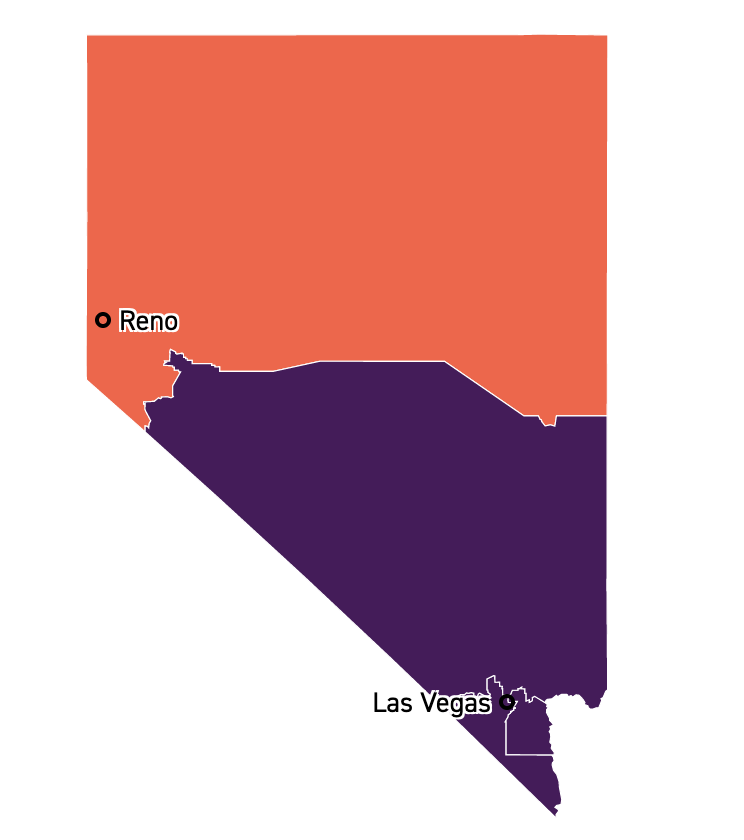Nevada
 A Change in Voting Systems
A Change in Voting Systems
Nevada, a key swing state, voted to implement ranked voting. Final Five Voting is a new primary election setup that gets rid of partisan primaries, re-enfranchises voters, and eliminates plurality voting. Rather than divisive, essentially pre-determined party primaries, ranked voting gives all competitors a fair chance and all voters a more direct voice. On their ballot, voters rank their choices in the primary, the top-choice votes are tallied, and a series of instant runoffs proceed to determine the true majority winner.
Alaska implemented Final Five in its most recent election, in which incumbent Sarah Palin lost to Mary Peltola in a major upset. Palin has since spoken out about her concerns of the system, mirroring the worry present in both parties that ranked choice voting will lead to more unpredictable outcomes. Now this new system will be brought to one of the nation’s most competitive states: Nevada. The initiative requires amending the state constitution and thus will be voted on again in 2024. It would then take effect for the first time in the 2026 election.
With Nevada’s support of the reform, a predicted 600,000 Nevada voters will be re-enfranchised. The state’s partisan calculations will likely shift. The increased competition will push representatives of the state to deliver results for voters, keep to their word, and focus on serving their state rather than having to make every move with their party’s support and getting re-elected in mind.
Senate
Nevada has two important elections that will undoubtedly influence the current political landscape: the gubernatorial and Senate races. It was interesting to understand the state of Trumpism in Nevada where two conservative, Trump endorsed candidates were running. This election is also critical for how we understand the Latino vote. The United States is quickly becoming a more pluralistic multi-racial society, with Latinos as the fastest growing minority ethnic group. Nearly 30% of Nevadans identify as Latinx, so Nevada has quickly become a test for Democrats and Republicans on how to attract Latinx voters, a population many esteemed consultants still consider to be monolithic.
Nevada had one of the closest races in the nation that ultimately determined who controls the Senate. The incumbent, Catherine Cortez Masto (D), the first Latina elected to the Senate, was trailing behind Trump-endorsed Adam Laxalt (R). This seat had been targeted by Republicans and Cortez-Masto was arguably the most vulnerable incumbent in the Senate. Cortez-Masto ran on the bread and butter Democratic issues with particular emphasis on abortion and reproductive justice, whereas Laxalt ran on reducing inflation and led Nevada’s election denial as Attorney General. Cortez-Masto won by half a point against Laxalt, meaning that Democrats will retain control on the Senate.
Governor
The Nevada governor’s race between incumbent Steve Sisolak (D) and Joe Lombardo (R), who was endorsed by Donald Trump, is one of the tightest gubernatorial races in the country. Sisolak ran on education and healthcare with an emphasis on abortion, whereas Lombardo ran as a pro-life candidate.
Both of these elections will be additional regional case studies on the importance of abortion and democracy to voters. Nevada is still receiving mail-in ballots as there is a state law that allows mail-in ballots to be received through Saturday as long as they were postmarked by election day. Since both races are so tight, it is unlikely that the election will be called before then. The remainder of the ballots are mail-in ballots from urban centers, so they are likely to be Democratic.
This article has been updated on 11/12/2022 with new results. This is a developing story. Stay with The Advocate for further updates.
